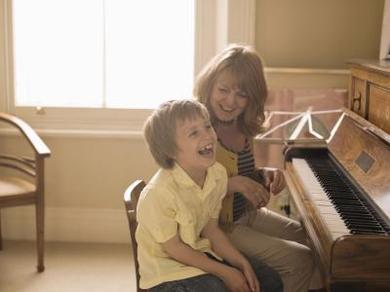How to Teach Piano to Young Children Using Games

By the time it feels like you’ve caught up with your youngster -- whoosh! -- he is off to the next thing. At this point, the thought of holding his attention for even a half-hour piano lesson seems daunting. The trick to teaching piano to young children, however, is to play short musical games to match your child’s pace and attention span. Soon your child might be begging to play more piano.
Items you will need
-
Piano
-
Keyboard printout
Step 1
Ask your child to tell you if the notes go up or down -- without peeking at your hands -- while you play a series of notes. This game works on listening skills, which are integral to piano lessons. After a few rounds of this game, let your child look at your hands and ask him where the notes are high and where they are low.
Step 2
Play a short melody with three to four notes only. Let your child repeat what you played. This call-and-response game will help your child learn by rote, meaning he uses his ear to repeat from an example. Vary this game by letting your child make up his own “response” to your “call.” This game teaches improvisation and improves creativity.
Step 3
Teach your child dynamics, or volume, in music by playing the conductor game. If you hold your hands up high above your head, your child should play forte, or loud; if your hands are low by your feet, your child plays piano, or soft. Let your child improvise his own music at the piano while you direct him to play loud or soft. Let your child have a chance to be the conductor while you play the piano.
Step 4
Number your child’s thumbs and fingers one through five -- the thumbs of both hands are one, index fingers are two, and so forth. Begin by asking your child to wiggle his "ones." Call out numbers and gradually get faster to see how fast your child can wiggle the correct fingers.
Step 5
Show your child how to find the note C on the piano. Have him place a token, such as a coin or small eraser, on the black keys situated in pairs on the keyboard. Point out that C is the white key directly below the first of the two black keys. Test your child by playing various keys and asking, “Is this C?”
Step 6
Make a print out of a piano keyboard and have your child color the keys C-D-E-F-G. Each should be a different color. This helps teach your child the five-finger scale, which is typically the main focus at the beginning of a piano lesson book.
